After painting fabric and seeing how much it stiffened the fabric, I knew I wanted to learn about painting with dyes instead. In anticipation I got a good tutorial book and asked for dyes for my just-around-the-corner birthday.
Living in Florida, I KNEW I wanted to dye inside, something that very few people do. I began to dye proof my studio. I didn’t want to put away everything that was pinned to my design walls, so I covered them with plastic.

Next, came the floor and table.
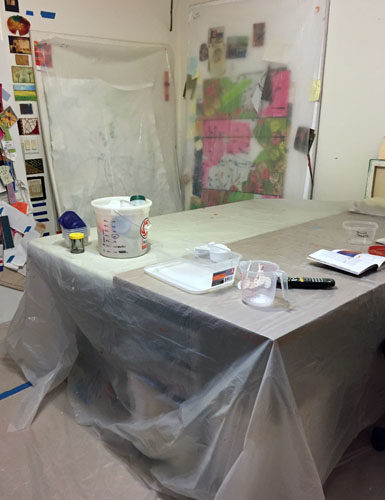
Maybe this seems like a lot of work, but I found that it really wasn’t too bad. As a matter of fact, putting away everything else was a bigger job.
I started with some simple experiments, getting to know my dye colors and techniques. I had a bunch of fabric (from YEARS ago) labeled “Treated with soda ash.” Just what I needed, so I did my first few experiments with that fabric. I couldn’t wait to wash it out and see what I got!
But, all my dark vibrant colors turned into wimpy pastels! Yuck!
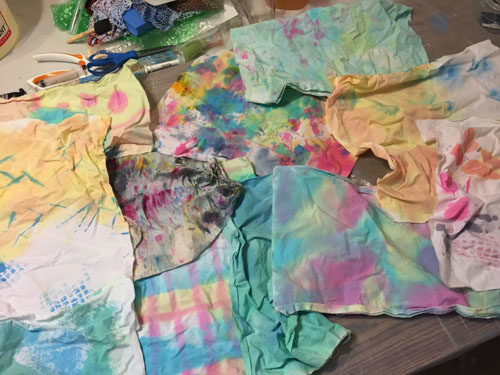
Just look at my pathetic color wheel. Even the black in the center was major washed out!
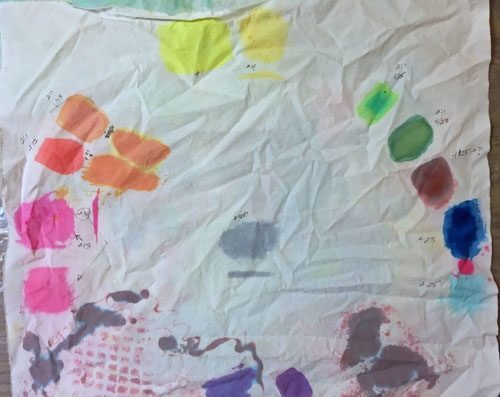
Here’s another example: my clean up rag before washing.
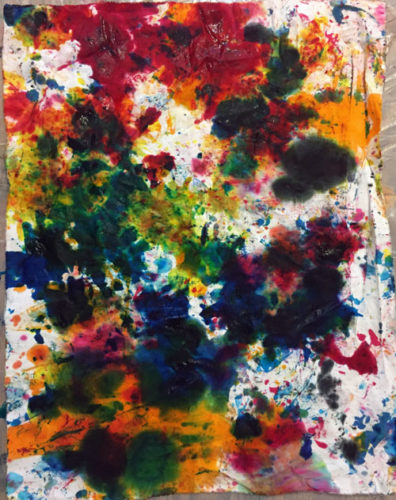
And after. I guess it’s not actually ugly, but it’s sure not what I expected, or wanted!

Clearly, the long-ago treatment to the fabric was the problem. I soaked the remaining fabric with soda ash, rigged up a clothesline, and hung it out to dry.
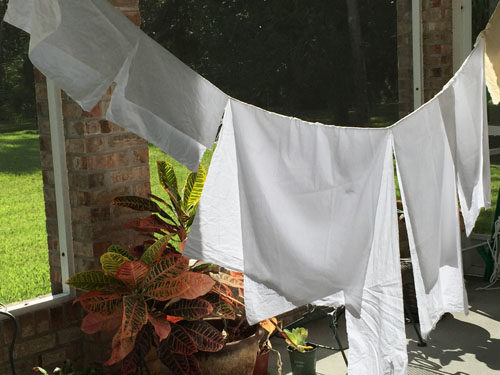
As an aside, do you have any idea how long it takes fabric to dry in humid Florida? It won’t even dry overnight! Well, that’s because the evening humidity is super high. In contrast, if I put it in direct sunlight it dries in about 15 minutes. Which means a little planning is required.
After all that, I was ready for Batch 2. I mixed a good bit of dye and thickener, so stay tuned for quite a few more examples.
Ellen Lindner
P.S. I’ve been using Ann Johnston’s book “Color by Design” as my reference. It’s super detailed and I recommend it.
P.P.S. My sewing machine died shortly before my dyes arrived, so the timing was good for a non-sewing distraction.

Thanks for all the time it takes to detail your projects!
You’re welcome, Gail. I’m chatty by nature, so I guess this is just an extension of that. Glad you’re enjoying it!
Can’t wait to see what you conclude! I have found that letting the dye dry on fabric and then heat setting with iron BEFORE rinsing also helps. But “contamination” is apt to be a problem in moving wet piece around. We laid it outside in sun. TMI, will
Await your report.
Hi Cindy. I think there as many ways to dye fabric as there are people teaching it! The process I’m using doesn’t mention heat, so I’m leaving it out. (Although you’re the second person to suggest it.) So far, I’m happy with the colors. I’ll have results to show soon.
Oh no! Dead sewing machine??! It does seem ironic: it died , so you dyed. Thanks for sharing the pics. I cannot bring myself to try this indoors. I think learning to dye is a fall and winter think in GA. Or maybe I’ll just try the thickened methods? I need a class…
Yeah, dead machine. My 17 year old Bernina finally bit the dust, which had been coming for a while. Maybe I’ll get it fixed. I’ve looked at some other brands but haven’t find anything I really like yet. Like I said…a good time to dye. With a heat index of 104 I just can’t bring myself to dye outside, but maybe I’ll find that it’s a winter activity. No stains yet!
I love your pun!
Le livre est un excellent:)))et je l’utilise tout le temps
Well, you challenged my High School French there, Marianne, but “Oui. Je suis d’accord.” (I agree.) I’m learning A LOT! My head is swimming with new information!